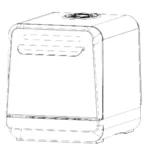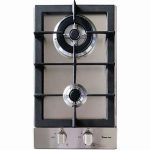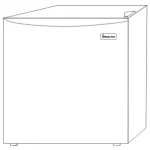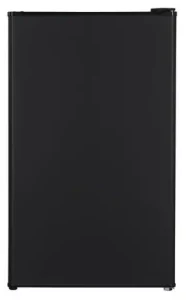

Magic Chef Compact Refrigerator

Magic Chef Compact Refrigerator
Model: HMR330WE / HMR330BE / HMR330SE
PLEASE READ THIS MANUAL CAREFULLY BEFORE USING YOUR REFRIGERATOR AND KEEP IT FOR FUTURE REFERENCE.
Product Registration
Thank you for purchasing a Magic Chef® product. The first step to protect your new product is to complete the product registration on our website: www.mcappliance.com/register. The benefits of registering your product include the following:
- Registering your product will allow us to contact you regarding a safety notification or product update.
- Registering your product will allow for more efficient warranty service processing when warranty service is required.
- Registering your product could act as your proof of purchase in the event of insurance loss.
Once again, thank you for purchasing a Magic Chef® product.
NAMES OF THE PARTS
MODEL NO. HMR330WE / HMR330BE / HMR330SE
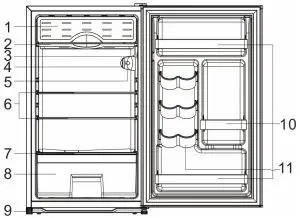
- Freezer Compartment
- Drain Pan
- Interior Light Switch
- Temperature Control Dial
- Temperature Control Box
- Glass Shelves
- Crisper Cover
- Crisper
- Leveling Leg
- Rack
- Can Rack
 WARNING
WARNING : Never touch the interior of the Freezer Chamber or frozen foods in the compartment with wet hands as this could result in frost bite.
: Never touch the interior of the Freezer Chamber or frozen foods in the compartment with wet hands as this could result in frost bite.
SPECIFICATIONS
Model# HMR330WE / HMR330BE / HMR330SE
| Product Description | Magic Chef Refrigerator | ||
| Model No. | HMR330WE / HMR330BE / HMR330SE | ||
| Capacity | 3.3 Cu. Ft. | ||
| Unit Dimensions (inches) | Width | Heiqht | Depth |
| 19.1″ | 32.9″ | 17.7″ | |
| Net Weight ( lbs) | 49.6 (lbs) | ||
IMPORTANT SAFETY INSTRUCTIONS
 To reduce the risk of fire, electrical shock, or injury follow these basic precautions when using your refrigerator.
To reduce the risk of fire, electrical shock, or injury follow these basic precautions when using your refrigerator.
- WARNING—- Keep ventilation openings in the appliance enclosure or in the built-in structure clear of obstruction.
- WARNING—- Do not touch the interior of the chiller compartment with wet hands. This could result in frost bite.
- WARNING—- Do not use mechanical devices or other means to accelerate the defrosting process, other than those recommended by the manufacturer.
- WARNING—- Do not damage the refrigerant circuit when handling, moving, or using the refrigerator.
- WARNING—- Do not use electrical appliances inside the food storage compartment of the refrigerator, unless they are of the type recommended by the manufacturer.
- WARNING–DANGER– Never allow children to play with, operate, or crawl inside the refrigerator.
Risk of child entrapment. Before you throw away your old refrigerator:- Take off the doors;
- Leave the shelves in place so that children may not easily climb inside.
- Unplug the refrigerator before carrying out user maintenance on it.
- This appliance is not intended for use by persons (including children) with reduced physical, sensory or mental capabilities, or lack of experience and knowledge, unless they have been given supervision or instruction concerning use of the appliance by a person responsible for their safety. Children should be supervised to ensure that they do not play with the appliance.
- If a component part is damaged, it must be replaced by the manufacturer, its service agent, or similar qualified persons in order to avoid a hazard.
- Please dispose of the refrigerator according to local regulations as the refrigerator contains flammable gas and refrigerant.
- Follow local regulations regarding disposal of the refrigerator due to flammable refrigerant and gas. All refrigeration products contain refrigerants, which under the guidelines of federal law must be removed before disposal. It is the consumer’s responsibility to comply with federal and local regulations when disposing of this product.
- This refrigerator is intended to be used in household and similar environments.
- Do not store or use gasoline or any flammable liquids inside or in the vicinity of this refrigerator.
- Do not use extension cords or ungrounded (two prong) adapters with this refrigerator. If the power cord is too short, have a qualified electrician install an outlet near the refrigerator.
Use of an extension cord can negatively affect the refrigerator’s performance. - If the supply cord is damaged, it must be replaced by the manufacturer, its service agent or similarly qualified person in order to avoid a hazard.
- Do not store explosive substances, such as aerosol cans with a flammable propellant, in this appliance.
- This appliance is intended to be used in household and similar applications such as:
- Staff kitchen areas in shops, offices, and other working environments;
- Farm houses and by clients in hotels, motels, and other residential type environments;
- Bed and breakfast type environments;
- Catering and similar non-retail applications.
- Lamp replacement by professionals.
IMPORTANT SAFETY INSTRUCTIONS
 WARNING WARNING |
To reduce the risk of fire, electrical shock, or injury when using your refrigerator, follow these basic precautions: |
|
|
INSTALLATION INSTRUCTIONS
- Remove the exterior and interior packing.
- Before connecting the refrigerator to the power source, let it stand upright for approximately 4 hours. This will reduce the possibility of a malfunction in the cooling system from improper handling during transportation.
- Clean the interior surface with lukewarm water using a soft cloth. (Cleaning instruction)
- This appliance is designed to be free standing only, and should not be recessed or built-in.
- Place your refrigerator on a floor that is strong enough to support the refrigerator when it is fully loaded.
- Allow 5 inches of space between the back and sides of the refrigerator, which allows the proper air ventilation. Adjust the feet to keep the refrigerator level.
- Locate the refrigerator away from direct sunlight and sources of heat (stove, heater, radiator, etc.).
Direct sunlight may affect the acrylic coating and heat sources may increase electrical consumption. Ambient temperature below 50°F (10°C) or above 85°F (29.4 °C) will hinder the performance of this appliance. This unit is not designed for use in a garage or any other outside installation. - Avoid locating the refrigerator in moist areas.
- Plug the refrigerator into dedicated, properly installed-grounded wall outlet. Do not under any circumstances cut or remove the third (ground) prong from the power cord. Any questions concerning power and/or grounding should be directed toward a certified electrician or an authorized service center. This unit is not designed to be installed in an RV or used with an inverter.
- After plugging the appliance into a wall outlet, turn the unit on and allow the unit to cool down for 2~3 hours under before placing food in the refrigerator or freezer compartment.
 WARNING
WARNING
Improper use of the grounded plug can result in the risk of electrical shock. If the power cord is damaged, have it replaced by an authorized service center.
This refrigerator should be properly grounded for your safety. The power cord of this refrigerator is equipped with a three-prong plug which mates with standard three prong wall outlets to minimize the possibility of electrical shock.
Do not, under any circumstances, cut or remove the third ground prong from the power cord supplied.
This refrigerator requires a standard 115/120 Volt A.C. ~/60Hz electrical outlet with three-prong ground.
This refrigerator is not designed to be used with an inverter.
The cord should be secured behind the refrigerator and n at left exposed or dangling to prevent accidental injury.
Never unplug the refrigerator by pulling the power cord. Always grip the plug firmly and pull straight out from the receptacle.
Do not use an extension cord with this appliance. If the power cord is too short, have a qualified electrician or service technician install an outlet near the appliance. Use of an extension cord can negatively affect the performance of the unit.
If any problems with the appliance persist, please contact our Customer Service Dept. to consult with a representative at 888 775-0202 or visit our website to request warranty service at www.mcappliance.com.
Do not attempt to repair or replace any part of your refrigerator unless it is specifically recommended in this manual. All other servicing should be referred to a qualified technician, so as to minimize the risk of possible ignition due to incorrect parts or improper service.
OPERATING YOUR REFRIGERATOR

- Your refrigerator has one control for regulating the temperature. The temperature control is located on the upper right hand corner of the interior compartment.
- The first time you turn the unit on, adjust the temperature control knobto “7” and run for at least 2 hours before putting foods inside. This will ensure the cabinet is thoroughly chilled before food is put in.
- The range of the refrigerator temperature control is from position “1” the cold to “7” the coldest.
Adjust the temperature control to the setting that best suits your needs. The setting of “4” should be appropriate for home or office refrigerator use. - Turning the temperature control knob to “O” position stops the cooling cycle but does not shut off the power to the unit.
- NOTE;
- If the unit is unplugged, loses power; you must wait 3 to 5 minutes before restarting the unit. If you attempt to restart before this time delay, the refrigerator will not start.
- Large amounts of food will lower the cooling efficiency of the appliance.
- Do not place the foods on the air outlet, and leave spaces for airflow.
- If you choose to change the thermostat setting, adjust thermostat control by one increment at a time. Allow several hours for temperature to stabilize between adjustments.
- This compartment is designed for the ice making and short-term storage of some commercially frozen foods.
- The temperature of the chiller compartment may not reach temperature low enough to store frozen foods safely and works well when the food is already frozen prior to storage.
- Place frozen food into the freezer as quickly as possible after purchase. If there are instructions on the packet, carefully follow these instructions regarding storage times.
Defrost the freezer compartment when the ice/ frost is approximately¼” thick. Set the thermostat dial to “O” to defrost. Remove all contents from the freezer compartment. Leave the freezer door open to allow accumulated ice/ frost to melt. Remove large pieces of ice as needed. Do not use hot water or other electric heating devices to melt the accumulated ice. After defrosting, remove accumulated ice/ water and wipe the freezer compartment dry with a soft cloth. Restart the unit per starting instructions.
NOTE: AII parts removed must be saved to do the reinstallation of the light bulb. Before removing the light bulb, unplug the appliance from the power supply. Failure to do so could result in electrical shock or personal injury.
- Remove the lamp cover by unscrewing.
- Unscrew old bulb from the lower hole at the thermostat control box.
- Replace the new bulb of the same voltage and screw size.
- Re-install the lamp cover by screwing.
CHANGING THE REVERSIBLE DOOR
CAUTION: To avoid personal injury to yourself and/or property, we recommend someone assist you during the door reversal process.
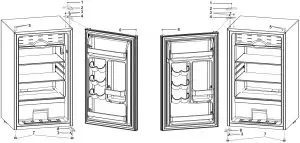
- M4X6 screw
- Door hinge cover
- M6X12 screw
- Door hinge pin
- Plug
- Door plug
- Adjustable foot
- Buttom hinge
Your refrigerator is built with a reversible door. You have the choice of either opening it from the left or the right side. In order to reserve the opening direction of your door, please follow these simple instructions:
| 1. Remove the hinge cover on the right top of the cabinet. 2. Remove the two screws (using a ratchet tool with a 7/16″ socket) that hold the top hinge to the cabinet. Keep these screws for later use. 3. Lift the top hinge straight up to free the pin from the socket on the top of the door. 4. Lift the door and place it on a padded surface to prevent scratching it. |
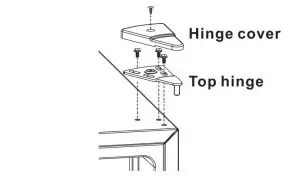 |
| 5. Remove the plug buttons from the upper left holes as illustrated and transfer them to the uncovered holes at the right side. Be sure to press the plug buttons firmly into the holes. 6. Remove the door plug from the door upper left holes as illustrated and transfer them to the uncovered holes at the right side. Be sure to press the door plug firmly into the holes. |
 |
| 7. Lay the cabinet on its side down on the floor. Remove the three screws that hold the bottom hinge to the cabinet using a 7 /16″ socket. Keep these screws for later use. 8. Insert the bottom hinge at the left side using the two screws previously removed in step 6. NOTE: Do not tighten screws. 9. Stand the cabinet. 10. Replace the door making sure the bottom socket enters the bottom hinge pin. |
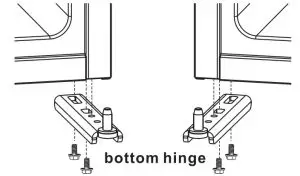 |
| 11. While holding the door in the closed position, secure the top hinge at the left side using the two screws previously removed at the beginning in step 2. Do not tighten the screws until the top of the door is leveled with the top cabinet. 12. Replace the hinge cover. |
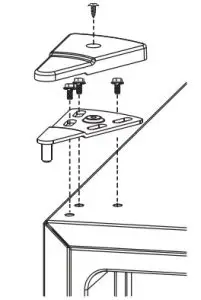 |
| 13. Replace plugs. 14. Tools Required: – 7 / 16″ socket-ratchet. – Putty knife or thin-blade screwdriver. |
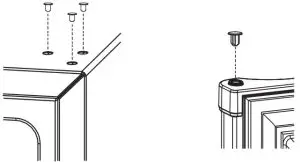 |
CARE AND MAINTENANCE
- Upon installation of your new appliance, it is recommended that it be cleaned thoroughly.
- Turn the temperature control knob to “O” and then unplug the unit from the wall outlet.
- Remove all food content.
- Wash the inside with a damp warm cloth soaked in lukewarm water and baking soda solution.
The solution should be about 2 tablespoons of baking soda to a quart of water. - Be sure to keep the door gasket (seal) clean to keep the unit running efficiently.
- The outside of the refrigerator should be cleaned with mild detergent and warm water.
- Dry the interior and exterior with a soft cloth.
- Turn the temperature control knob to “O” and then unplug the unit from the wall outlet.
- Remove all the food.
- Clean the refrigerator.
- Leave the door open slightly to avoid possible formation of condensation, mold, or odor.
- Use extreme caution in the case of children. The unit should not be accessible to child’s play.
- Short vacations: Leave the refrigerator operating during vacations of less than three weeks.
- Long vacations: If the appliance will not be used for several months, remove all food and unplug the power cord. Clean and dry the interior thoroughly. To prevent odor and mold growth, leave the door open slightly: blocking it open if necessary or have the door removed.
- Turn the temperature control knob to “O” and then unplug the unit from the wall outlet.
- Remove all the food.
- Securely tape down all loose items inside your refrigerator.
- Tape the doors shut.
- Be sure the refrigerator stays in the upright position during transportation.
- The refrigerator should be located in the coolest area of the room, away from heat producing appliances or heating ducts, and out of the direct sunlight.
- Let hot foods cool to room temperature before placing in the refrigerator. Overloading the refrigerator forces the compressor to run longer. Foods that freeze too slowly may lose quality, or spoil.
- Be sure to wrap foods properly, and wipe containers dry before placing them in the refrigerator.
This cuts down on frost build-up inside the refrigerator. - Organize and label food to reduce door openings and extended searches. Remove as many items as needed at one time, and close the door as soon as possible.
TROUBLESHOOTING GUIDE
You can solve many common refrigerator problems easily, saving you the cost of a possible service call. Try the suggestions below to see if you can solve the problem before calling for service.
| PROBLEM | POSSIBLE CAUSE |
| Refrigerator does not operate. | Not plugged in. The circuit breaker tripped or a blown fuse. |
| Compressor turns on and off frequently. | The room temperature is hotter than normal. A large amount of food has been added to the refrigerator. The door is opened too often. The door is not closed completely. The temperature control is not set correctly. The door gasket does not seal properly. The refrigerator does not have the correct clearances. The refrigerator has recently been disconnected for a period of time. 4 hours are required for the refriqerator to cool down completely. |
| Temperature inside the refrigerator is too warm. | Temperature control is set too warm. Turn the control to a cooler setting and allow several hours for the temperature to stabilize. Door is kept open too long or is opened too frequently. Warm air enters the refrigerator every time the door is opened. Open the door less often. The door is not closed completely. The door gasket does not seal properly. A large amount of warm or hot food might have been stored recently. Wait until the refrigerator has had a chance to reach its selected temperature. The refrigerator has recently been disconnected for a period of time. 4 hours are required for the refrigerator to cool down completely. |
| Temperature inside the refrigerator is too cold. | Temperature control is set too cold. Turn the control to a warmer setting and allow several hours for the temperature to stabilize. |
| Temperature of external refrigerator surface is warm. | The exterior refrigerator walls can be as much as. 30°F warmer than room temperature. This is normal while the compressor works to transfer heat from inside the refrigerator cabinet. |
| Popping or cracking sound when compressor comes on. | Metal parts undergo expansion and contraction, as in hot water pipes. This is normal. Sound will level off or disappear as refrigerator continues to run. |
| Bubbling or gurgling sound, like water boiling. | Refrigerant (used to cool refrigerator) is circulatinQ throuqhout the system. This is normal. |
| Vibrations. | Check to assure that the refrigerator is on a level surface. Floor is uneven or weak. Refrigerator rocks on the floor when it is moved slightly. Be sure floor can adequately support refrigerator. Level the refrigerator by putting wood or metal shims under part of the refrigerator. The refrigerator is touching the wall. Re-level the refrigerator and move it from the wall. See “Installation Instructions”. |
| Moisture forms on inside refrigerator walls. | Weather is hot and humid, which increases internal rate of frost build-up. This is normal. Door is slightly open. Door is kept open too long, or is opened too frequently. Open the door less often. The door is not sealed properly. |
| Moisture forms on outside of refrigerator. | Door is slightly open, causing cold air from inside the refrigerator to meet warm moist air from outside. |
| The door will not close properly. | The refrigerator is not on a level surface. The gasket is dirty. |

Limited Warranty
MC Appliance Corporation warrants each new Compact Refrigerator to be free from defects in material and workmanship, and agrees to remedy any such defect or to furnish a new part{s), at the company’s option, for any part{s) of the unit that has failed during the warranty period. Parts and labor expenses are covered on this unit for a period of one year from the date of purchase. A copy of the dated sales receipt or invoice is required to receive warranty service, replacement or refund.
In addition, MC Appliance Corporation warrants the compressor (parts only) to be free from defects in material and workmanship for a period of five years. The consumer is responsible for all labor and transportation expenses related to the diagnosis and replacement of the compressor after the initial one-year warranty expires. In the event the unit requires replacement or refund under the terms of this warranty, the consumer is responsible for all transportation expenses to return the unit to our factory prior to receiving a replacement unit or refund. A copy of the dated sales receipt/invoice is required to receive warranty service, replacement or refund.
This warranty covers appliances in use within the contiguous United States, Alaska, Hawaii and Puerto Rico. This warranty does not cover the following:
- Damages due to shipping damage or improper installation.
- Damages due to misuse or abuse.
- Content losses due to failure of the unit.
- Inside components such as door panels, door shelves, racks, light bulbs, etc.
- Repairs performed by unauthorized service agents.
- Service calls that do not involve defects in material and workmanship such as instructions on proper use of the product or improper installation.
- Replacement or resetting of house fuses or circuit breakers.
- Failure of this product if used for other purposes than its intended purpose.
- Disposal costs for any failed unit not returned to our factory.
- Any delivery/installation costs incurred as the result of a unit that fails to perform as specified.
- Expenses for travel and transportation for product service if your appliance is located in a remote area where service by an authorized service technician is not available.
- The removal and reinstallation of your appliance if it is installed in an inaccessible location or is not installed in accordance with published installation instructions.
- Refunds for non repairable products are limited to the price paid for the unit per the sales receipt.
- This warranty is non transferable. This warranty applies only to the original purchaser and does not extend to any subsequent owner(s).
Limitations of Remedies and Exclusions:
Product repair in accordance with the terms herein, is your sole and exclusive remedy under this limited warranty. Any and all implied warranties including merchantability and fitness for a particular purpose are hereby limited to one year or the shortest period allowed by law. MC Appliance
Corporation is not liable for incidental or consequential damages and no representative or person is authorized to assume for us any other liability in connection with the sale of this product. Under no circumstances is the consumer permitted to return this unit to the factory without the prior written consent of MC Appliance Corporation.
Some states prohibit the exclusion or limitation of incidental or consequential damages, or limitations on implied warranties. This warranty gives you specific legal rights, and you may also have other rights which vary from state to state.
| Model | Parts & Labor | Compressor (Parts Only) | Type of Service |
| HMR330WE | One Year | Five Years | Carry In |
| HMR330BE | One Year | Five Years | Carry In |
| HMR330SE | One Year | Five Years | Carry In |
For Service or Assistance please call 888-775-0202 or visit us on the web at www.mcappliance.com to request warranty service or order parts.
DOWNLOAD RESOURCES
- Magic Chef Compact Refrigerator [pdf] User Manual 3.3 Cu.Ft. Compact Refrigerator, HMR330WE, HMR330BE, HMR330SE
- Read more: https://manuals.plus/magic-chef/compact-refrigerator-manual#ixzz7dfPEiSoG
FAQ’S
How long does it take for Magic Chef mini fridge to cool?
4 hours are required for the refrigerator to cool down completely. Temperature inside the refrigerator is too cold. Temperature control is set too cold. Turn the control to a warmer setting and allow several hours for the temperature to stabilize.
How do I know if my refrigerator is working properly?
Check the temperature control dial on the front of your appliance to make sure it is set at the proper temperature. If the dial is set too high, food will spoil quickly. If it is set too low, your appliance will not work properly. Check the temperature of your freezer compartment with an appliance thermometer. The temperature should be between 0°F and 5°F (-18°C and -15°C). If it is not, adjust the temperature control dial until it reaches the proper setting. Make sure that all doors are closed tightly to keep cold air in and warm air out. Check your owner’s manual for other tips on how to keep your appliance working properly.
Why do you have to wait 24 hours to plug in a fridge?
Its because the compressor lubrication oil could get into the cylinder of the compressor and if not given plenty of time to drain back into the oil sump at the bottom of the compressor, could cause major compressor valve damage on start up. 2 or more hours is a good rule to observe.
What temperature should Magic Chef refrigerator be set at?
The Magic Chef mini fridge temperature range for ideal operation is between 50 and 85 degrees Fahrenheit, and temperatures outside this range will impact the fridge’s ability to maintain a food-safe temperature, according to The Magic Chef mini fridge user manual.
What happens if you don’t let a fridge settle?
After being transported, unless it’s been kept totally upright, the oil inside the compressor may leak into the refrigeration system. This oil needs to slowly settle back into the compressor.
What is the red button for in a Magic Chef refrigerator?
It is used to defrost your mini fridge. If you turn the temp down and press the button the fridge will defrost the freezer portion.
Why is my Magic Chef refrigerator not cooling?
Check the condenser coils to determine if they are dirty if the condenser coils are dirty, clean them. The condenser fan motor draws air though the condenser coils and over the compressor. If the condenser fan motor is not working properly, the refrigerator won’t cool properly.
How do you clean the coils on a Magic Chef refrigerator?
Before performing any internal repairs in refrigerator you’ll want to make sure to unplug. It. Next we remove the back panel from the refrigerator. With the back of the fridge removed.
How do I reset my Magic Chef refrigerator?
Right here where you put the screwdriver in right there and just turn it I dont know if
you’te going to be able to hear it or not but it’ll start right up you turn it just a little bitty
bit.
How do you know if your mini fridge is broken?
7 Major Warning Signs That Your Refrigerator Is Broken
Your Food is Spoiling Quickly.
There’s Condensation.
Ice Is Building Up in the Freezer.
The Motor is Hot.
It’s Loud.
There’s Water on Your Floor.
Signs Your Refrigerator is Broken.
Can a mini fridge be repaired?
You know nothing about mini fridge repair and you can’t afford the call out charge of a refrigerator technician, but luckily these sturdy little appliances can be fixed with some simple troubleshooting and repair tips.
How do you test a compressor on a mini fridge?
Now the first thing we’re going to do is start with the two bottom ones and the two bottom ones you’re gonna get a reading of right around 10.
VIDEO

Magic Chef Compact Refrigerator
www://mcappliance.com/
